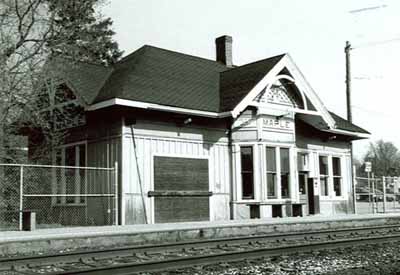Former Canadian National Railway Station
Heritage Railway Station of Canada
Maple, Ontario

General view of the place
(© A. M. de Fort-Menares, 1992.)
Address :
26 Station Street, Maple, Ontario
Recognition Statute:
Heritage Railway Stations Protection Act (R.S.C., 1985, c. 52 (4th Supp.))
Designation Date:
1992-11-06
Dates:
-
1903 to 1903
(Construction)
Event, Person, Organization:
-
Grand Trunk Railway
(Organization)
-
Canadian National Railways
(Organization)
Other Name(s):
-
Grand Trunk Railway Station
(Other Name)
Research Report Number:
RS-139
Description of Historic Place
The Former Canadian National Railway Station was built in 1903 to designs prepared by the Grand Trunk Railway (GTR), which was later acquired by the Canadian National Railways (CNR). It is a small one-storey wooden Queen Anne building located at 26 Station St. Today it serves commuter traffic as a GO Transit station.
Heritage Value
The Former Canadian National Railway Station at Maple, Ontario has been designated a heritage railway station because of its historical, architectural and environmental significance.
The Maple station was built in 1903 by the Grand Trunk Railway (GTR) to handle increased traffic on what was already an established rail line. The line had been built through Maple in the 1853 by the Ontario, Simcoe and Lake Huron Union Company Railway, which was later acquired by the GTR. Construction of this station was an expression of GTR support for the continuing growth of Maple as an small industrial and vacation centre. At the time it was built, the GTR was up-grading facilities, an activity which included rebuilding many of its stations. The Maple GTR station is a simple timber-frame building with wood cladding applied in picturesque Stick Style patterns, extracting a maximum visual effect from a relatively simple technique. Its detail is domestic in scale and typical of its Queen Anne Revival style.
The heritage value of the Maple station resides in the high degree of integrity with which it witnesses the station built in 1903. It lies in the station’s surviving form, spatial organization, domestic scale, wooden detailing, functional organization, and in its evocative rural setting.
Sources: Heritage Character Statement, the former Maple Grand Trunk Railway Station, March 1993; Heritage Assessment Report RSR-139, 1992.
Character-Defining Elements
Character-defining elements of the Former Canadian National Railway Station include:
the rectangular footprint, one-storey massing, and hipped roof of the station, broken by gables and a chimney, the use of large gables to incorporate visual interest in the roofline from three perspectives, the simplicity of the station’s original form, symmetrically arranged around its polygonal telegrapher’s bay, its Queen Anne Revival proportions, the fine balance inherent in its overall vertical definition, articulation of its exterior wall surfaces as three horizontal bands or registers, defined by board and batten siding, diagonal V-jointed panels and narrow vertical boarding, the rhythmic placement of apertures below a consistent string course, its stick-style treatment of applied framing elements and wooden cladding applied in ornamental patterns; brackets, acorn pendants, trellis work, bargeboard, and mileage signage on the bay, the applied framing elements and skeletal braces emphasizing the timber structure of the north and south gables, the integrity and legibility of its original materials; wood siding, wood shingle, wood trim and details, the station’s platform frame construction technology, the richness and integrity of all original fabrics, finishes and furnishings inside the station including: the waiting room entirely sheathed in beaded boarding, elaborate coved wood cornice and flat ceiling, the semicircular moulded surround of the ticket window with its three boxed roundels, the deep Italianate cornice and diagonally-patterned dado in the agent's office and waiting room, and the simple boarded ceiling, walls, and plain trim of the baggage room, the continued legibility of the station’s original functional spaces (waiting room, agent’s office and baggage room), their spatial volumes, and differentiation by level of ornamentation.